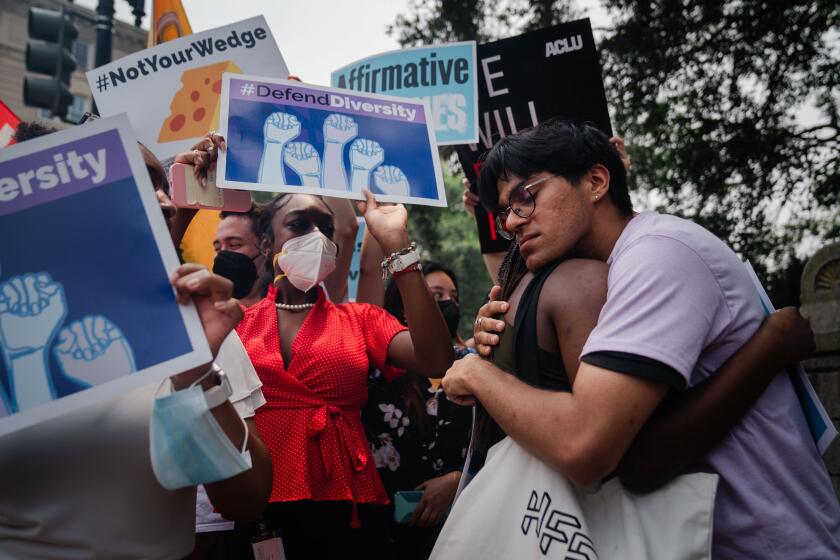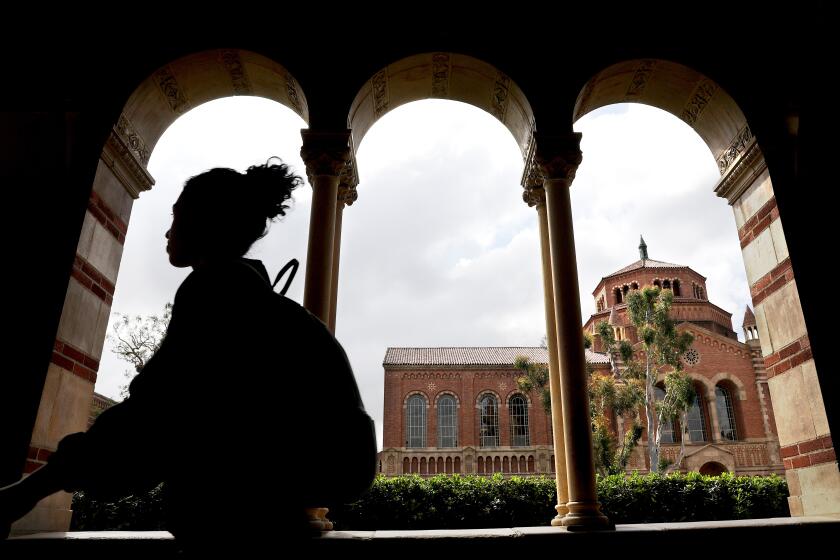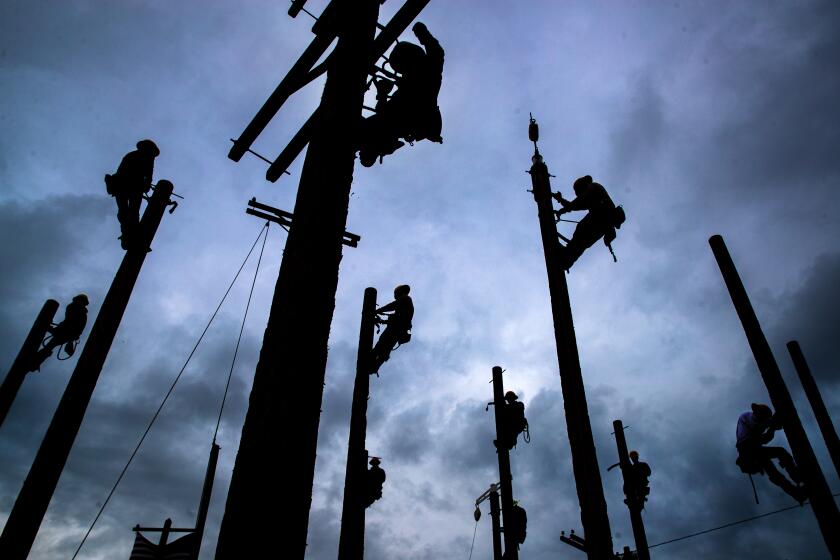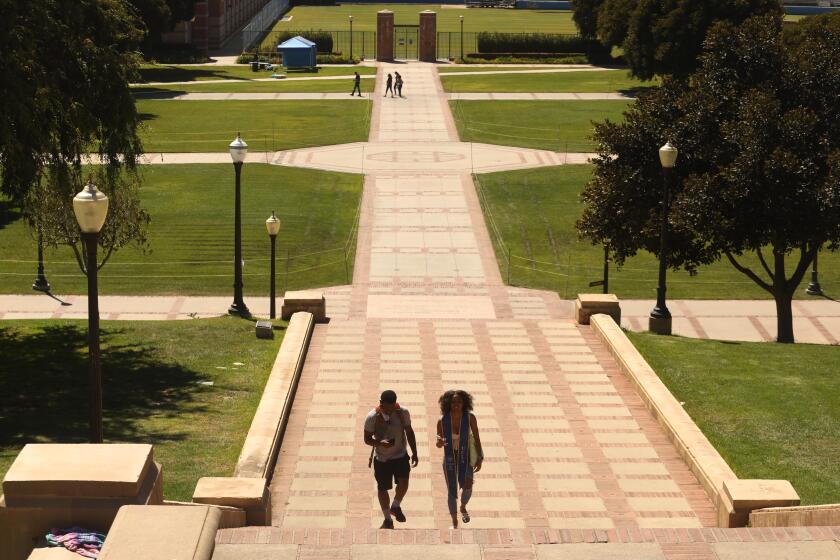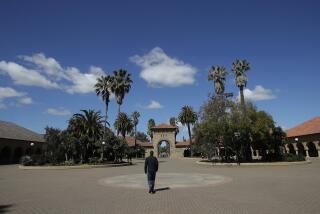‘We’re really worried’: What do colleges do now after affirmative action ruling?
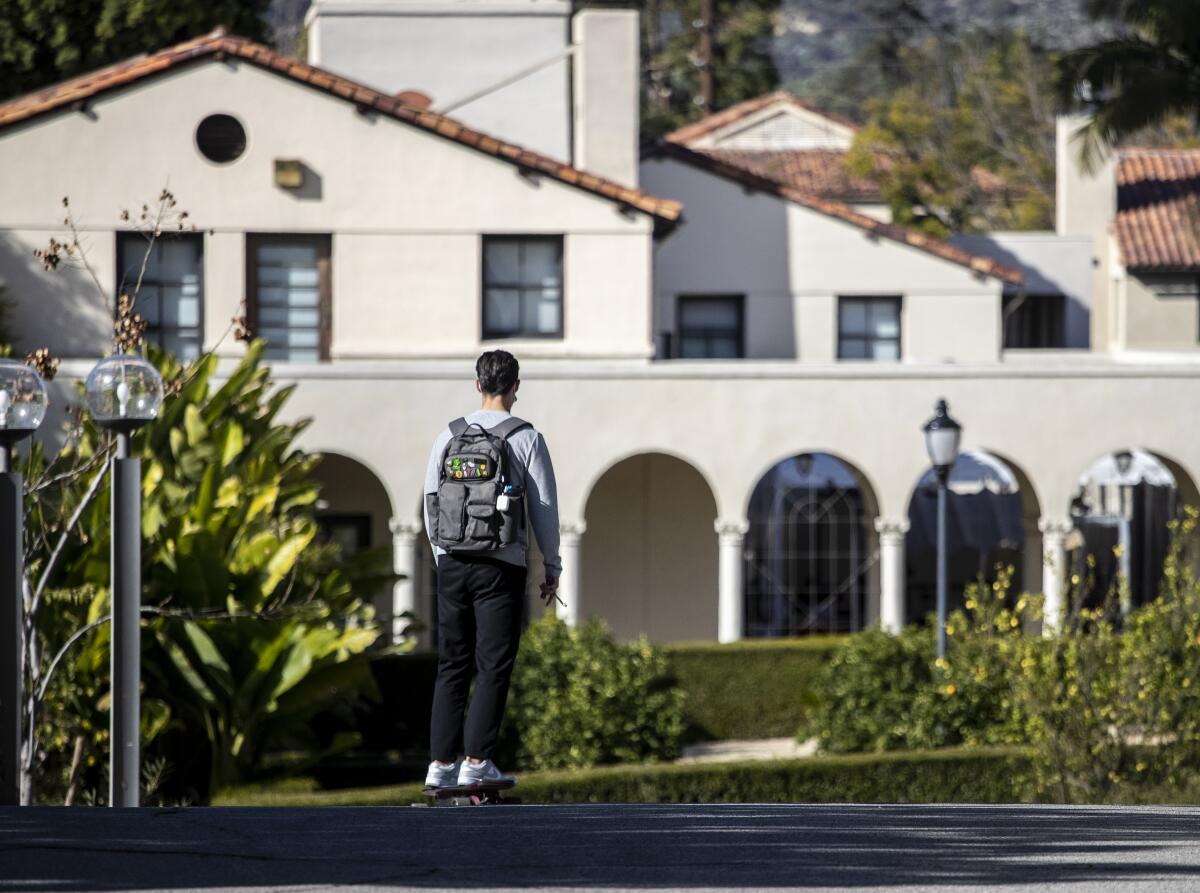
The U.S. Supreme Court’s landmark decision Thursday striking down affirmative action has intensified angst among many higher education leaders who say extending access to a diversity of students could become a challenging, high-cost and labor-intensive effort steeped in uncertainties.
Many also fear that applications from Black, Latino and other students of color will drop, and say a key priority will be to assure those students that they matter and that campus commitment to diversity remains strong.
“We’re really worried about private colleges and universities and what it means for representation,” said Christopher Nellum, executive director of the Education Trust-West, a nonprofit organization focused on education equity. “Young people, particularly young people of color … are going receive this as a message that they don’t belong.”
The sweeping decision eliminated the use of race in admissions decisions nationwide for the first time since the high court allowed the practice in 1978 to promote diversity. Students for Fair Admissions, a nonprofit opposed to racial preferences, alleged that Harvard and the University of North Carolina violate constitutional guarantees of equal protection by considering race in admissions decisions — and that the Ivy League campus specifically discriminates against Asian Americans.
In another major reversal, the Supreme Court forbids the use of race as an admissions factor at colleges and universities.
The high court agreed in a majority opinion written by Chief Justice John G. Roberts Jr. The ruling noted that the appellate court found Harvard’s affirmative action program resulted in fewer admissions of Asian American students and that the Ivy League campus’ assertion that race was never used as a negative factor in selections “cannot withstand scrutiny.”
But Roberts also wrote that “nothing prohibits universities from considering an applicant’s discussion of how race affected the applicant’s life,” which will continue to allow students to write about their backgrounds in college essays. Roberts added, however, that institutions must consider that background in the context of applicants’ “quality of character or unique ability that the particular applicant can contribute to the university” and treat them based on experiences as individuals, not on the basis of race.
The decision won’t directly affect the University of California or California State University. State voters banned affirmative action at public campuses by approving Proposition 209 in 1996.
Many campus leaders at public and private universities expressed disappointment with the decision, saying the court ruling had removed an essential tool to help create diverse classes. But they assured students of color that they had earned their place in college and vowed to continuing building a welcoming culture for all.
“USC has long understood that excellence and diversity are inextricably intertwined,” USC President Carol Folt said in an Instagram statement. “This decision will not impact our commitment to creating a campus that is welcoming, diverse, and inclusive ... where differing backgrounds and points of view are embraced, where ideas collide, beliefs are challenged and innovation thrives.”
Some college officials worry about the cost of such efforts — or whether their state leaders have the political will to carry them out.
The ruling comes at a time of deep financial pressures in higher education, with decreasing enrollment and family questions over the value of a high-cost college education during economically tough times.
UC Berkeley law professor John Yoo said the UC system exemplifies how to build diversity without using race as a factor in admission, and noted other campuses also can do so using geography, income or other factors. He supported the court decision, saying past rulings that allowed race to be considered “caused disaster” — such as those affirming school segregation, denying citizenship to people of African descent and justifying the mass incarceration of Japanese Americans during World War II.
“It restores the fundamental promise of a colorblind Constitution,” Yoo said.
But more than 80 private institutions in the state have been free to consider race in admissions decisions, and many have watched the growing challenges to diversity initiatives with alarm.
“All of us are very frustrated that narrow political considerations are threatening to change the way that we teach and learn and the conditions under which our students learn — and that’s a tragedy,” said Pomona College President G. Gabrielle Starr. “I feel like we’re being driven by a political environment that increasingly feels that race is a dividing force in our country.”
Starr and other college leaders pointed out that only a small number of highly sought-after institutions consider race as a factor in apportioning seats.
Debate leading up to the Supreme Court’s decision has stirred up plenty of misconceptions. We break down the myths and explain the reality.
Among 1,364 four-year institutions, according to a 2019 Pew Research study, only 17 admitted fewer than 10% of applicants — including Stanford, Harvard and Yale — and 29 accepted between 10% and 20%, including USC.
In reality, most institutions accept the majority of students who apply — looking primarily at grades and transcripts to evaluate whether they have a good chance of succeeding, said Martin Van Der Werf of the Georgetown University Center on Education and the Workforce.
But he and others said the high court decision still carries a powerful punch because of how it will be perceived.
“Symbolically it ... sends a signal of what’s important and whether people are being treated fairly across the board,” Van Der Werf said. “What they will take away from it is that we no longer have a commitment in this country to try to use college admissions as a way to right centuries of wrongs against people from different racial and ethnic groups that have never really had as fair a shake in this country.”
Another potential effect, he said, would be perpetuating the advantages of those from privileged backgrounds. Students at more selective colleges have higher graduation rates and powerful alumni networks that often result in enhanced careers and earnings. If fewer disadvantaged students have access to them, they could lose out on those lifelong benefits, he said.
“Are we reserving our most selective colleges for the people who are most likely to succeed anyway?” Van Der Werf said. “That goes against the ideals that the higher education system of this country sets for itself.”
Community college graduates in healthcare fields can outearn humanities students even from elite universities such as Stanford, UC Berkeley and UCLA, underscoring how much majors can matter.
Some Black and Latino students fear that axing affirmative action will decrease their numbers and make college life even more alienating.
Kailyn Wilkerson, a Cal State Long Beach senior, said she is often one of just a few Black students in her political science courses and feels extra pressure to maintain high grades so others don’t question her place at the university.
“Just because I am there, I don’t always feel like I’m supposed to be there,” she said. Wilkerson plans to apply for doctorate and law school programs. The ruling is already shaping her calculus on where she applies — she’s now considering historically Black universities, where she will be welcome.
Maggie De Leon, an Asian American rising senior at Downtown Magnets High School, said she thinks all students will get a fairer shot at college admissions without race as a consideration. De Leon, whose college resume features a 4.3 GPA, seven Advanced Placement classes and election as class president two years running, said she hopes her achievements will be evaluated on an equal basis as other applicants’.
With affirmative action in place, she said, “People will look and see you’re part of a demographic that historically has been in college so they won’t want to take you because they’re looking for a different kind of applicant. It takes away from my educational opportunities.”
Jennifer Zeller, a 55-year-old Korean American college admissions counselor in Beverly Grove, believes the ruling will help Asian American students and lift aspirations in the college admissions process.
“We’re seeing Asian Americans who are stellar in so many other spheres. They’re leaders, stellar musicians, athletes, doing tons of community service. They are doing everything right, and they’re still not getting in,” she said. “If they weren’t Asian, you just have this instinct that they would have gotten in with the same credentials.”
The California experience
The University of California has long been a laboratory for experimentation in how to build diverse college classes without using race. In 1998, the first admission year after the passage of Proposition 209, the number of California Black and Latino first-year students plunged by nearly half at UCLA and UC Berkeley.
Since then, UC campuses have made notable strides. Black and Latino students increased to 43% of the admitted first-year class of Californians for fall 2022 compared with about 20% before Proposition 209. For the third straight year, Latinos were the largest ethnic group of admitted students at 37%, followed by Asian Americans at 35%, white students at 19% and Black students at 6%.
UC enrollment still does not fully reflect the state’s racial and ethnic makeup, however, falling particularly short with Latinos.
At UCLA, the number and share of California first-year Black and Latino students fully rebounded by 2021 from the precipitous fall after Proposition 209. Black students grew to number 346, or 7.6%, compared with 259, or 7.3%, in 1995. Latino numbers grew to 1,185, or 26%, from 790, or 22.4%, during that same period.
But the progress has taken substantial time, effort and resources. UCLA devotes up to $2 million annually to recruit applicants in diverse communities and convince them to accept their admission offers.
As the Supreme Court weighs affirmative action, the University of California’s struggle with diversity since a 1996 ban offers lessons.
Youlonda Copeland-Morgan, the chief architect of UCLA’s rebound effort who recently retired as vice provost of enrollment management, said the university worked with Black churches and L.A. Unified schools in underserved neighborhoods, created early academic outreach programs, offered more scholarships for low-income students and sent top-level officials to visit schools.
Overall, the UC system has spent an estimated half a billion dollars on its diversity efforts. The work has included two major reforms: an admission guarantee to top-performing students at most high schools and a comprehensive review process that uses several factors — including special talents and location of home and high school — in addition to grades and coursework to evaluate applicants.
But moving from an admissions process based on quantitative metrics such as grades to a holistic evaluation of multiple factors takes time and resources. UC Riverside, for instance, is in a transition process that will have taken a few years to complete and entail hiring additional application readers, said Veronica Zendejas, director of undergraduate admissions.
One Oakland-based nonprofit, College Track, begins working with promising students in middle school and provides them with tutoring, test prep, college advising, leadership development and other services to help them graduate from college. But the cost over a decade can amount to $100,000 per student, said Shirley M. Collado, the nonprofit’s president.
Such efforts deliver clear results — but their cost and complexity are daunting, said Angel B. Pérez, chief executive of the National Assn. for College Admission Counseling.
“If we learned anything from California, state institutions have to invest a lot of money to meet some of their diversity goals,” he said. “But California is an outlier. There’s just not the same kind of resources or political will in other places that there is in California. The admissions officers are feeling like, ‘Well, what resources will I be given to do this work?’ There’s a lot of nervousness with a lot of unknowns.”
Many institutions may not be able to afford to use income as a proxy for race in the way UC and other campuses with large public budgets or private endowments have, Pérez said. Although enrolling more low-income students increases racial and ethnic diversity, that strategy also requires more financial aid. California has a large financial aid program, but most other states are less generous, he said.
The challenge ahead
Some college officials also are questioning whether the ban on affirmative action will go beyond admissions to affect race-based financial aid, academic support programs, campus resource centers or ethnic-themed housing.
In anticipation of the Supreme Court decision, the Assn. of Independent California Colleges and Universities sent resources to member campuses to help them prepare for the end of affirmative action. Colleges and universities were advised to take an inventory of programs or policies that deal with race and ethnicity, including scholarships, and encouraged to conduct legal reviews of how any programs might have to change.
Copeland-Morgan, however, advised institutions not to overreact to the ruling by pulling back from anything that involves race or ethnicity, as many California campuses did immediately after passage of Proposition 209. Targeted recruitment is still allowed in the state, she said.
But UCLA makes a point to not only connect with students from underepresented racial and ethnic groups but also those from rural areas, low-income and immigrant family backgrounds, former foster youth, first-generation scholars and others who may need more information about how to prepare for competitive college admissions.
Race-based financial aid or other campus programs might eventually be subject to challenge, some experts said, but admissions is likely to remain the main focus for now.
As for admissions, campuses already are considering how to move forward after affirmative action.
Starr said Pomona will probably expand its recruiting outreach to focus more heavily on local high schoolers as well as student-athletes and military veterans. The campus also will work even more closely with community colleges to attract transfer students and enhance pipeline programs that help prepare high school students for competitive college admissions, she said.
At Occidental College, campus officials have partnered with more community organizations to recruit from high schools with large numbers of students underrepresented in higher education, said Maricela Martinez, vice president of enrollment. But she worries that such students will no longer feel welcome.
“To what extent it will impact our work on our campus, it’s hard to know,” she said. “My biggest fear is that it’ll discourage students from applying.”
Kristen Soares, president of the Assn. of Independent California Colleges and Universities, expressed similar concerns. Although 60 of the association’s 80-plus campuses are designated “Hispanic-Serving Institutions” with Latino students making up at least a quarter of their enrollment, she said the court ruling could create a “chilling effect” that would discourage more underrepresented students from applying.
“A lot of work just goes into ensuring that we recruit and retain diverse undergraduates,” she said. “It’s going to make our work more difficult.”
The impact of the decision could be felt as early as this summer at campuses that admit students on a rolling basis, and as graduate schools finalize their rosters for the fall.
“They’ll have to immediately make some changes,” Soares said.
Times staff writer Jeong Park contributed to this report.
More to Read
Sign up for Essential California
The most important California stories and recommendations in your inbox every morning.
You may occasionally receive promotional content from the Los Angeles Times.
